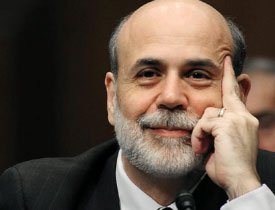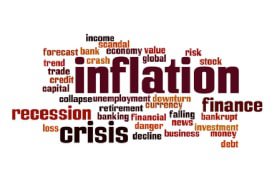Fed May Target Even Higher Inflation, Consumer Prices
 Bullion.Directory precious metals analysis 4 May, 2017
Bullion.Directory precious metals analysis 4 May, 2017
By Stefan Gleason
President of Money Metals Exchange
The Federal Reserve has given itself the objective of engineering an inflation rate of around 2%. However, there are many ways in which real-world inflation can potentially outpace the Fed’s 2% target.
Firstly, the Fed’s preferred inflation gauges are flawed. The so-called “core” rate of consumer price inflation strips out food and energy costs. The core Personal Consumption Expenditures (PCE) index has also been criticized for underweighting housing and medical costs.
The PCE number for March, which came out on May 1st, shows the Fed’s favored inflation gauge running at 1.6% year over year. That’s down slightly from the previous month’s reading of 1.8% (2.1% for the headline unadjusted PCE).
Since 2012, the core inflation rate has been running below the Fed’s 2% target. That has caused investors to grow complacent toward inflation risk. They seem to be operating under the assumption that 2% is a ceiling.
That is a dangerous assumption – not only because of food and energy inflation not being properly accounted for, but also because even the official “core” number could rise well above target for extended periods.
Fed Insiders Call for 4% Inflation Target
The 2% target itself isn’t set in stone. In fact, some current and former Fed governors would like to see the central bank pursue a more flexible inflation objective. Peterson Institute economist Olivier Blanchard argues the Fed ought to raise its target to 4% in order to make up for several years of below-2% inflation.
Former Federal Reserve chairman Ben Bernanke recently wrote a piece for the Brookings Institute in which he proposed ways to re-jigger the Fed’s inflation target. According to Bernanke, “in a changing world of imperfect credibility and incomplete information, private-sector inflation expectations are not so easy to manage.”
In other words, the Fed lacks the knowledge and credibility to be able to directly control what businesses and individuals think future inflation rates will be. That’s a problem for the central bank to the extent that expectations for inflation can be self-fulfilling and fail to match up with the centrally planned target.
What’s a central planner to do? Bernanke suggests implementing a more flexible inflation target.
“Looking forward, it is likely that the determinants of the ‘optimal’ inflation target—such as the prevailing real interest rate, the costs of inflation, and the nature of the monetary policy transmission mechanism—will change over time,” he wrote.
Bernanke Proposes Targeting Higher Prices on Goods and Services
Rather than a fixed numerical target, Bernanke argues the Fed could target price levels. A 2% annual inflation rate implies that a basket of goods costing $100 today would, in 20 years, cost $148.59. If the Fed targets that particular price level, then years of undershooting 2% inflation would require years of overshooting to stay on target.
Ben Bernanke’s conclusion: “The adoption of price-level targeting would be preferable to raising the inflation target.”
Armed with novel justifications for letting inflation run higher, the Fed is far from being held down by its putative 2% inflation objective. The risk for investors is that inflation at some point does start running higher than 2% – perhaps significantly higher.
 Once unleashed, inflation could prove hard for policy makers to keep a lid on. The Fed can try to manipulate mass psychology.
Once unleashed, inflation could prove hard for policy makers to keep a lid on. The Fed can try to manipulate mass psychology.
It can control short-term interest rates and try to restrain money supply growth. However, it cannot directly control money velocity or long-term interest rates.
Recent yields on 10-year (2.3%) and 30-year (2.9%) U.S. Treasury bonds reflect the widespread belief that the Federal Reserve will hold inflation at 2% and allow bondholders to eke out small real returns.
Yet with government debt at $20 trillion and rising… with forecasts for the debt to GDP ratio to rise well over 100% to Third World levels in the next decade… the government can’t afford to keep paying out positive real rates of interest on its bonds.
The world’s biggest debtor will have to default or (more likely) devalue the currency in which its debts are denominated. Maybe not this year or next. But in the foreseeable future, bondholders will face the prospect of staggering real losses as inflation rates outstrip low fixed yields on debt instruments.
Inflation Punishes Savers and Bails Out Debtors
Inflation serves as a sort of hidden tax. It punishes savers and consumers as it rewards and bails out debtors – the biggest of all being the U.S. government. The temptation for Congress to rely on the Fed’s printing press to finance its otherwise unsustainable deficit spending is simply too great.
 Bonds and other dollar-denominated financial instruments are currently priced as if inflation won’t be a problem for the next three decades. Meanwhile, gold, silver, and other hard assets are selling at discounts because most investors aren’t concerned about inflation protection.
Bonds and other dollar-denominated financial instruments are currently priced as if inflation won’t be a problem for the next three decades. Meanwhile, gold, silver, and other hard assets are selling at discounts because most investors aren’t concerned about inflation protection.
They should be. Now is the time to be concerned.
By the time rising inflation rates are a full-fledged economic reality, you can bet precious metals prices will be far higher than where they sit today.












 Material provided on the Bullion.Directory website is strictly for informational purposes only. The content is developed from sources believed to be providing accurate information. No information on this website is intended as investment, tax or legal advice and must not be relied upon as such. Please consult legal or tax professionals for specific information regarding your individual situation. Precious metals carry risk and investors requiring advice should always consult a properly qualified advisor. Bullion.Directory, it's staff or affiliates do not accept any liability for loss, damages, or loss of profit resulting from readers investment decisions.
Material provided on the Bullion.Directory website is strictly for informational purposes only. The content is developed from sources believed to be providing accurate information. No information on this website is intended as investment, tax or legal advice and must not be relied upon as such. Please consult legal or tax professionals for specific information regarding your individual situation. Precious metals carry risk and investors requiring advice should always consult a properly qualified advisor. Bullion.Directory, it's staff or affiliates do not accept any liability for loss, damages, or loss of profit resulting from readers investment decisions.

Leave a Reply